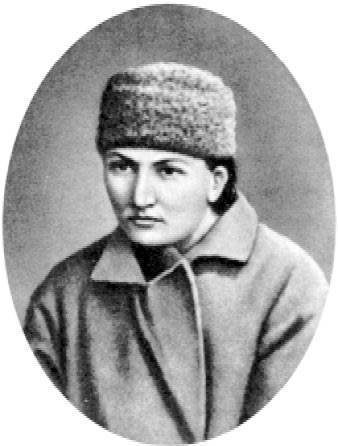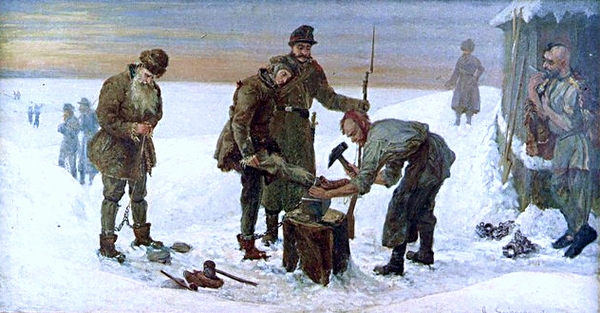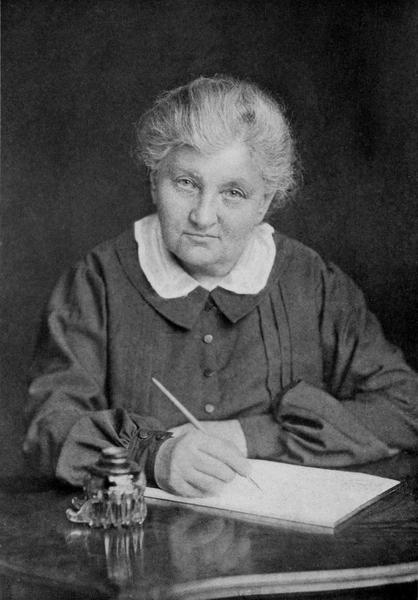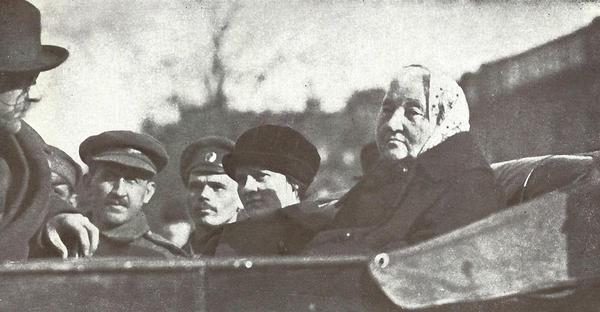July 25, 2025 Hello , Is ICE arresting people in your town? Before I get to today's story, let me tell you what's happening here. Last week in Spokane, ICE arrested an 18-year-old student when he showed up at his scheduled
immigration hearing. Alex Lopez was taken to Tacoma, WA for deportation.
Dylan “Alex” Alexander Saquic Lopez (Provided by Francis Paul Lopez Guzman) Spokesman Review. Read Alex's story in the News and Links section below. Also this week in Spokane, nine people were arrested on federal conspiracy charges after they tried to block an ICE vehicle from carrying away two legal immigrants. More on that story below as well. Could people protesting deportation become political prisoners in the United States? Let me know what's happening where you live. Freedom and democracy have always required
sacrifice. Today's feature story is about a woman who become known as the Little Grandmother of the Russian Revolution. Though she spent many years exiled to hard labor in Siberia as the first woman political prisoner of her nation, her confidence in the final outcome of the struggle for freedom was
unshakable.
Unshakable Faith in the
Struggle for Freedom
Her name was Yekaterina Konstantinovna Breshko-Breshkovskaya, but like her American friends, we'll call her Catherine. Her revolutionary ideas sprouted organically from her environment, a huge estate in Chernigov province which is now in northern Ukraine. Her aristocratic father owned hundreds of serfs and the family lived in
wealth and comfort. But as a child of five, Catherine's heart broke for the chauffeur, the chamber-maid, the laborer, the serf... "Men would come to the master begging for bread; women would come weeping, demanding back their children of whom they had been robbed. These things tormented me as a child,
pursued me into my bed, where I would lie awake for hours, unable to sleep thinking of all the horrors that surrounded me." Her parents were liberal thinkers, at
least as far as their kind went. They allowed Catherine, when she was 16, to start a school near their estate and and teach peasants to read and write. And when Russian Czar Alexander II emancipated all the serfs of Russia in 1861, she helped her father free his fiefdom. But this wasn't enough to heal her broken heart. First, the fact that the serfs had no where to go and could not support themselves if they did not have land. She believed all the aristocrat should divide up their lands and give peasants their own plots or a portion of land to farm communally. Also, she wanted freedom for herself! After some argument with her parents, at 17, she set off for St. Petersburg alone. Emancipation had not resolved the misery of poor rural people in Russia and she wanted to help forge a political remedy for them. In the capitol city, she gravitated to other young populists envisioning a better society. Like her, some young women who, "had won their personal
freedom, now wanted to make use of it, not for their own personal enjoyment but to carry to the people the knowledge that had emancipated them."
Catherine Breshkovskaya in her youth. Photo courtesy of the Russian Humanitarian Encyclopedic Dictionary. Over the next ten years, Catherine taught school, went back home and got married, and had a baby son, whom she turned over to her sister-in-law before again leaving home. "I knew that I could not be a mother and a revolutionary." She joined the Narodniks, members of the Russian Intelligentsia who left the city on campaigns called "Going to the People." Catherine and a couple friends got false passports in the summer of 1874 and set out to the countryside in disguise. One source says she dressed as a nun, another mentions her guise was as an itinerant laborer. She and her companions settled in villages and tried to inspire the peasants to form a mass movement to overthrow the monarchy and create a form of agrarian socialism. Passing out leaflets and talking against the Czar, Catherine knew she risked arrest and after several years the net drew
tighter. When a police officer stopped her to check her passport, he grew suspicious when she acted too bold for a peasant. Catherine was arrested, then held in solitary
confinement for a year before she and thirty-six other women finally went to trial in January 1878. They were charged with dispersing "revolutionary propaganda" and the other women were all acquitted. Catherine, however, was defiant, refusing to recognize the authority of the court and proudly announcing she belonged to the Russian socialistic and revolutionary party. She was convicted and sentenced to 20-years in a penal colony in Siberia.
This painting depicts a prisoner being shackled in a Siberia labor camp. Painted by Aleksander
Sochaczewski, a Polish rebel who survived 5-years in a Russian penal colony, public domain. When Catherine had nearly served her first year working in the
mines, her sentence was commuted to exile rather than hard labor, though she was still a prisoner. She escaped in 1881, but was recaptured and sentenced to another four years in the mines. It was during those years, an American journalist and explorer discovered her in his travels across Siberia. She impressed George Kennan as strong and intelligent, and though he could see traces of suffering in her face, she seemed warm, impulsive and generous. She was 41, but he guessed her to be 35. "...her thick, dark wavy hair, which had been cut in prison at the mines, was streaked here and there with grey...," Kennen wrote. Almost the last words that she said to me were: "Mr Kennan, we may die in exile, and our children may die in exile, and our children's children may die in exile, but something will come of it at last." Kennan had worked overseas for Associated Press and written articles for major American magazines, publicly supporting the Czarist Russian government. His meetings with Catherine and other political exiles
in Siberia eroded his positive picture of the Russian autocracy. Back home in the US, he became a loud supporter of Russian democracy, lecturing and writing his
two volume book Siberia and The Exile System and introducing Catherine's story to Americans. Kennan said later: "All my standards of courage, of fortitude, and of heroic self-sacrifice have been raised for all time, and raised by the hand of a woman". Remaining in exile for another twelve years after Kennan's visit, Catherine did not complain of the injustice and hardship she endured. A stream of other political prisoners passing through kept her spirits up. "I had much to inspire and sustain me," she said. Then in 1897, Catherine was freed by a general amnesty for prisoners marking the coronation of the Nicholas II, the last Tsar of Russia. Though now age 52, she went right back to her political activities. Searching out a new generation of revolutionaries she traveled the country illegally, organizing the Socialist-Revolutionary Party. Authorities were on the lookout for her and after many close calls, she left Russia to travel the world and raise money for the party. Arriving in the US in 1904, she was known from George Kennan's book and became a sensation. Nearly 3000 people showed up in Boston to welcome
her. Women's Journal reported, "When the 'Grand Old Lady' got up to speak, the great audience rose en masse. Handkerchiefs waved,
hats were flung into the air, words of affection in five languages were rained upon her." Catherine also visited New York and Chicago meeting American feminists
who she would correspond with for years. Americans contributed $10,000 to her Socialist Revolutionary Party and nicknamed her Grandmother of the Revolution. In Russian, the common people called her Babushka.
Published by Little, Brown and Co, Boston, 1918; photographer unknown
Emma Goldman an American political activist and writer shared a conversation she had with Catherine: "Dear Babushka," I once said to her, "how have you been able to keep your youth after so many years of prison and exile?" She answered, "And how did you manage to retain yours, living in this soul-destroying, materialistic country?" Catherine returned to Russia as the 1905 as mass political and social unrest broke out, including worker strikes, peasant revolts, and military mutinies directed at Tsar Nicholas II and the autocracy. This revolution
lead to Russia's first constitutional monarchy. Even so, Catherine and others continued to agitate against the government and she was arrested a second time and
sentenced to life in exile in Siberia in 1910. Though her American friends pleaded for her release and for Catherine to come to America, she refused. Her place was with the Russian people. After the Bolshevik Revolution in February 1917, which led to the abdication of Tsar Nicholas II and the establishment of a provisional government, Catherine was liberated and triumphantly returned to Petrograd, (St. Petersburg was renamed by the revolutionaries) where she was honored as the grandmother of the Russian Revolution.
Catherine Breshkovskaya returns in triumph from exile in Siberia, 1917. Picture licensed from Alamy. The Atlantic wrote in April 1917, Babushka — in English we can come no nearer the meaning of the word than ‘dear little Grannie’ — has lived to see her dream come
true: her dream of a free Russia, delivered from the Romanoffs, from the ‘Bochophiles,’ from despotism, into the safe-keeping of the Russian people and the social democracy. But alas, in the October Revolution later that year, the Bolsheviks and Vladimir Lenin seized power leading to the creation of the Soviet Union. This was not the social democracy Catherine envisioned. She exiled herself from her homeland, first living in Paris and then settling in Czechoslovakia with her fellow-revolutionary Maria Kolenkina, a friendship that spanned more than 50 years.
From 1871-1917 Catherine spent 14 years in prison camps; 13 years in penal servitude in Siberia; 10 years in revolutionary work; 6 years under strict surveillance by the police; 2 years in exile outside the country and only 8 months, in 1917, of freedom in her work in Russia.
Was Catherine's faith and struggle all in vain? Let me know what you think!
Like my article today? Forward this
email to share with family and friends.
Sources https://www.jstor.org/stable/2491766?read-now=1&seq=1#page_scan_tab_contents
Eighteen-year-old Alex Lopez left Guatemala last year after a gang threatened to kill him. He claimed asylum in the US and entered the country legally. He was allowed to join an uncle living
in Spokane until his case was resolved in immigration court. Now, he's been taken to Tacoma, WA for deportation.
Alex is not a criminal, he's a much-liked high school student. He has legal status in the US. Read his story
here... As this boy awaits his fate in a cell, nine people, let's call them political prisoners, got out on bail here this week. I saw Ben Stuckarts parents in church every Sunday when I
attended St. Ann's Catholic Community in Spokane. His name is familiar here because he was president of the city council some years ago. Now, he's facing federal conspiracy charges for trying to halt the deportation of two young men from Venezuela whom he sponsored. The men had entered the US legally, gaining asylum after waiting at the US border and checking in every day for five months. They both worked full time jobs at Walmart and obeyed all laws. Ben says they were kidnapped June 11th, that he had no choice but to try and stop their abduction and that he did not cross the line "from protest to violence and destruction" as
charged by the federal government. Ben and the other eight protestors are in Trump's bullseye. Some call Ben a lawbreaker, some call him passionate and
prophetic. That exactly what people called Catherine Breshkovsky when the Russian government sent her off to Siberia, the first woman sentenced to hard labor in that vast icy
land due to her politics.
Follow me on social media
This newsletter is a reader-supported publication. To support my work, consider becoming a paid subscriber.
Read
a great book? Have a burning question? Let me know. If you know someone who might enjoy my newsletter or books, please forward this e-mail. I will never spam you or sell your email address, you can unsubscribe anytime at the link below. To find out more about my books, how I help students, teachers, librarians and writers visit my website at www.MaryCronkFarrell.com. Contact me at MaryCronkFarrell@gmail.com. Click here to subscribe to this newsletter. |
|
|







